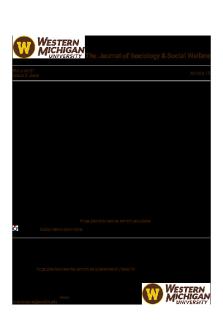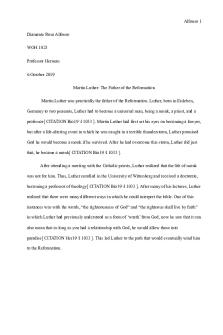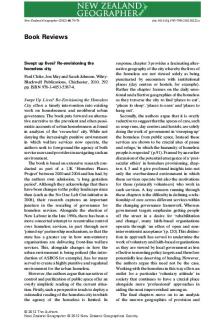Elders Living Alone: Frailty and the Perception of Choice. Robert L. Rubinstein, Janet E. Killbride and Sharon Nagy. Reviewed by Martin B. Tracy, The University of Iowa PDF

| Title | Elders Living Alone: Frailty and the Perception of Choice. Robert L. Rubinstein, Janet E. Killbride and Sharon Nagy. Reviewed by Martin B. Tracy, The University of Iowa |
|---|---|
| Author | Martin B Tracy |
| Pages | 5 |
| File Size | 221.8 KB |
| File Type | |
| Total Downloads | 55 |
| Total Views | 263 |
Summary
The Journal of Sociology & Social Welfare Volume 21 Article 19 Issue 2 June May 1994 Review of Elders Living Alone: Frailty and the Perception of Choice. Robert L. Rubinstein, Janet E. Killbride and Sharon Nagy. Reviewed by Martin B. Tracy, The University of Iowa. Martin B. Tracy University of I...
Description
The Journal of Sociology & Social Welfare Volume 21 Issue 2 June
Article 19
May 1994
Review of Elders Living Alone: Frailty and the Perception of Choice. Robert L. Rubinstein, Janet E. Killbride and Sharon Nagy. Reviewed by Martin B. Tracy, The University of Iowa. Martin B. Tracy University of Iowa
Follow this and additional works at: https://scholarworks.wmich.edu/jssw Part of the Social Work Commons
Recommended Citation Tracy, Martin B. (1994) "Review of Elders Living Alone: Frailty and the Perception of Choice. Robert L. Rubinstein, Janet E. Killbride and Sharon Nagy. Reviewed by Martin B. Tracy, The University of Iowa.," The Journal of Sociology & Social Welfare: Vol. 21 : Iss. 2 , Article 19. Available at: https://scholarworks.wmich.edu/jssw/vol21/iss2/19
This Book Review is brought to you by the Western Michigan University School of Social Work. For more information, please contact [email protected].
Book Reviews
175
current educational and social issues, such as school choice. As a compilation of writings that describe and evaluate many parent involvement intervention research programs, this book is positively recommended as a welcome contribution to the literature. Although the book is devoted to issues of program, practice and evaluation research, those interested in policy development will find useful material included from which to base a review of and plan selected social aspects of educational policy. The programmatic bases of a framework for understanding and improving parental involvement can be found throughout this edited collection of writings. The intermediate level of the book makes it suitable for readers that have a background in concepts and practice related to social issues in education. This book will serve as a resource for applied social scientists who conduct research on minority parental involvement in schooling. It will be valuable to those who wish to gain a practical understanding of the direct operations of parent involvement programs, and will be useful as a resource for pupil personnel in providing material on the cultures of populations-at-risk in school settings, information about innovative prograraming, and ideas about practical strategies for helping parents who wish to further their children's education. Steven R. Rose Louisiana State University
Robert L. Rubinstein, Janet E. Killbride and Sharon Nagy. Elders Living Alone: Frailty and the Perception of Choice. Hawthorne: NY: Aldine de Gruyter, 1992. $35.95 hardcover; $18.95 papercover. The dominant values of individualism and independence among American elderly are well known, if not well understood, throughout the world. Indeed, the American penchant for independence in old age is quite incomprehensible to many persons from societies where the idea of an elderly individual living alone is truly unthinkable. This insightful book uses case illustrations to explore a sample of the American experience of independent living through
176
Journal of Sociology & Social Welfare
the lives of selected frail elderly persons in Philadelphia that are profoundly shaped by their fervent desire to stay in their own homes and residences even under extremely adverse conditions. The analysis focuses on whether or not individualistic frail elderly who live alone can age successfully despite limitations of health, support systems, and environment. The discussion also examines successful aging, defined as continued personal growth and development, in terms of the factors that make it possible. Drawing on survey interviews of 52 persons age 65 and over who suffer from a variety of poor health conditions that limit their activities of daily living, case illustrations are used to demonstrate that even in circumstances where housing conditions are minimal and substandard most frail elderly to choose independent living. Clearly, what is most threatening about aging among the interviewees is the loss of independence which is equated with removal from their home environment. This is true even when the home is located in a neighborhood that has been so altered that the elderly person is virtually isolated from normal social contacts and interactions. The study is a penetrating attempt to help us understand the attitudes of frail elderly persons who live alone with the intent of providing information that will assist relatives and social service agencies in creating more viable and acceptable choices and options. The survey shows that it is not just the presence or lack of community services, extended families, or income support systems, that keeps most unattached elderly in their homes. While these are important factors, it is the culture of independence and autonomy that plays the most critical role. A loss of independence is perceived as a loss of freedom. Freedom means control over decisions of daily functions and the freedom of choice even when choices are very limited. As choices become more constrained due to health and other circumstances, the personal value of choice increases. When big choices are reduced the importance of small choices increases. Space is reduced but there is more control over it. This is described as a miniaturization of satisfaction or ethos of freedom in the small.
Book Reviews
177
In addition to the value of independence, people prefer to live alone in their own homes so as not to be a burden on family or friends, having privacy when in pain or exhaustion, being their own boss, and not having to adjust to the needs of others. Another important contributing feature is the interviewees', long- term residence in one place. After living 20, 30, 40, or more years in the same house, there is a close association between person and place. There is ease, comfort, and an interconnectedness between the individual and the living space that is often very profound. Moreover, it easier to live with familiar fears and discomforts than to face new ones that relocation would entail. The case interviews stress the impact of the reduction of community life and support for the elderly who live alone. In many cases, the reduced mobility of individuals severely impacts their ability to shop and socialize. This is further compounded by social and economic changes in their neighborhood which often excludes them from the mainstream of community life. It is not just the abiding desire for independence that is examined, but also the individual's ability to age successfully. In this regard, several structural constraints come into play, including, access to health care, low income, and deteriorating conditions of house and neighborhood. Not surprisingly, those who age the most successfully are people who have an adequate income that gives them the freedom to make choices and allows them to purchase goods and services that nourish their minds as well as feeding their bodies. These are also individuals who have prepared themselves for living independently by cultivating skills in the activities of daily living, including household management, hobbies and intellectual pursuits. The most successful have a history of continuity in personal habits and of malleability under extenuating circumstances. They are also more likely to have an emotional support network and be aware of social services that might be available to them. The book is an illuminating study in the conflicting nature of individualism and collective responsibility. It raises meaningful questions about the burden of specific aspects of American
178
Journal of Sociology & Social Welfare
culture and the lack of social and income support for the frail elderly. The analytical approach is relatively easy to follow, although it tends to be somewhat erudite in the beginning chapters. The case studies are particularly captivating reading. This book is certainly recommended for anyone interested in gaining a better understanding of the characteristics of frail elderly who live alone and their needs. Martin B. Tracy The University of Iowa...
Similar Free PDFs

Martin - the egg and the sperm
- 17 Pages

Question OF THE Month l
- 4 Pages

The road by robert frost
- 8 Pages
Popular Institutions
- Tinajero National High School - Annex
- Politeknik Caltex Riau
- Yokohama City University
- SGT University
- University of Al-Qadisiyah
- Divine Word College of Vigan
- Techniek College Rotterdam
- Universidade de Santiago
- Universiti Teknologi MARA Cawangan Johor Kampus Pasir Gudang
- Poltekkes Kemenkes Yogyakarta
- Baguio City National High School
- Colegio san marcos
- preparatoria uno
- Centro de Bachillerato Tecnológico Industrial y de Servicios No. 107
- Dalian Maritime University
- Quang Trung Secondary School
- Colegio Tecnológico en Informática
- Corporación Regional de Educación Superior
- Grupo CEDVA
- Dar Al Uloom University
- Centro de Estudios Preuniversitarios de la Universidad Nacional de Ingeniería
- 上智大学
- Aakash International School, Nuna Majara
- San Felipe Neri Catholic School
- Kang Chiao International School - New Taipei City
- Misamis Occidental National High School
- Institución Educativa Escuela Normal Juan Ladrilleros
- Kolehiyo ng Pantukan
- Batanes State College
- Instituto Continental
- Sekolah Menengah Kejuruan Kesehatan Kaltara (Tarakan)
- Colegio de La Inmaculada Concepcion - Cebu












